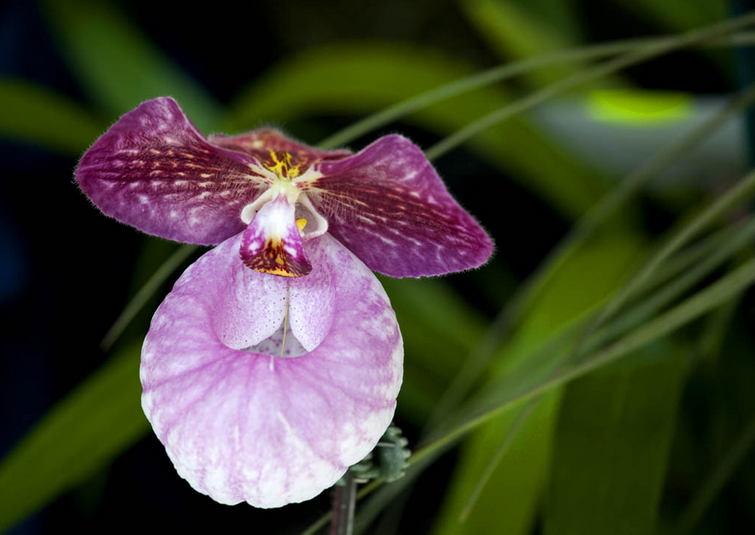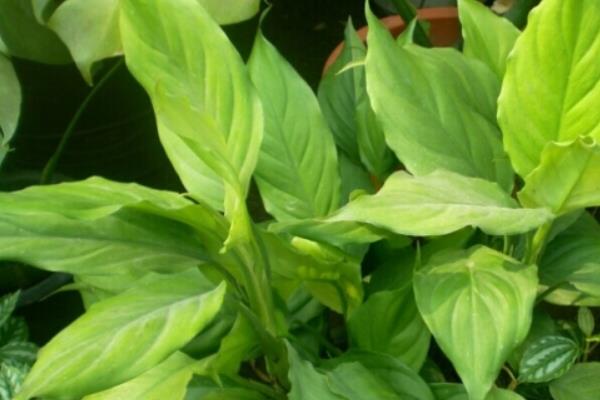Culture method of potted flower and leaf taro
Potted flower-leaf taro culture method, flower-leaf taro alias colorful leaf taro, dichromatic taro. Its leaves are shaped like ivory, the leaves are covered with a variety of colorful patterns, bright colors, constitute a natural pattern, quite beautiful. If decorated in the interior with 1-2 pots of flower and leaf taro, coupled with asparagus, ivy, ferns and so on, it will add a lot of vitality to the room.
For raising flower and leaf taro at home, the overwintering stored tubers can be taken out from April to May, and the small tubers around the large tubers can be peeled off and dried slightly, then they can be put on the pot to sprout. Choose a flowerpot with a diameter of about 25 cm, fill it with wet sawdust, and plant the tuber in the basin matrix. The mouth of the pot is arched with iron wire, which is covered with plastic film, and the temperature inside the film can be maintained for 25 ℃. Pay attention to the substrate in the basin should not be too wet, the temperature should not be too low, otherwise it will cause tuber rot. The bud can be exposed for about 1 week, and when the bud has 2 or 3 leaves, it can be planted in the pot.
Potted soil is best mixed with porous, porous and well-drained soil, which can be mixed with 5 parts of garden soil, 3 parts of rotten leaf soil and 2 parts of sandy soil. Before planting, the tuber should be soaked and disinfected in 500-800 topiramate for 5-10 minutes, the effect will be better. Before planting, put a layer of coarse sand or coarse cinder on the bottom of the basin to facilitate drainage and aeration, and then put a layer of culture soil on it, which can put an appropriate amount of base fertilizer. After filling the culture soil to a certain depth, put the flower leaf taro in the middle of the basin. It is best to put the different color varieties 2n3 stems equidistant, fill the soil, make the leaves exposed to the basin soil, pour water once, put the basin in a semi-shady, warm place to maintain, the growth can be restored in about a week, and normal maintenance management can be carried out.
The key points of maintenance and management of potted taro are high temperature, moisture and semi-shade. The suitable temperature for the growth of taro is 2530 ℃, and not less than 15 ℃ at night. Watering and fertilization should be timely and appropriate. During the growth period, the water supply should be adequate, and the basin soil should always be kept moist. In the peak growing season, the mixed fertilizer solution of nitrogen, phosphorus and potassium is generally applied every 7 to 10 days, which is better with the all-element flower fertilizer sold on the market, which can make the leaf color more bright. If too much nitrogen fertilizer is applied, the color spots on the leaves will fade, affecting the ornamental effect. Do not stain the leaves when applying fertilizer solution, so as not to scorch and rot the leaves. It is better to water the basin soil in spring and autumn to keep the soil moist.
If too much watering and poor drainage, it is easy to cause tuber rot; if the basin soil is too dry, it is easy to make the plant withered and wrinkled, affecting ornamental. In summer, the temperature is high and the water evaporates quickly, which is also the peak growing season of taro. In addition to adequate watering, it is also necessary to spray water to the surface of the leaf and the ground around the basin, so as to cool down and increase the air humidity in a small area around the basin. This is very beneficial to keeping the leaf color of taro beautiful and the leaf appearance straight. Autumn is the growth and development stage of flower-leaf taro tuber, and it is necessary to apply more phosphorus and potassium fertilizer to promote the rapid growth of tuber. At the end of autumn, when the temperature dropped below 15 ℃, the leaves withered and fell off and entered the dormancy period. At this time, watering should be reduced to promote the dormancy of tubers. Flower and leaf taro in the growing period, like semi-shade, avoid strong direct sunlight, but the light is too weak, it is easy to cause overgrowth, the leaves are thin and long, and it is easy to lose bright color and luster; if the light is too strong, the tender leaves will also be burned. the above is the introduction to the cultivation methods of potted taro.
Methods and skills of cultivating potted taro alias colorful leaf taro and colorful taro. Sexual preference for high temperature, high humidity, semi-overcast environment. Not resistant to cold, drought, avoid direct sunlight. The suitable temperature for growth is 22-28 ℃, and the room temperature in winter is between 8-10 ℃. Suitable for loose, fertile slightly acidic soil. Common cultivated varieties are. White leaf taro, John Peter, red cloud, Haiou, headlights, white emperor, egret, red wave, sunset and so on. The florescence is from May to October. The method of reproduction is mainly based on the method of dividing plants. Cultivation tips: using the split method, cut the tubers with 2-3 buds from the mother plant with a sharp knife, or buy the tubers from the flower market. The basin soil is mixed with 2 parts of garden soil, 2 parts of rotten leaf soil, 1 part of rotten organic fertilizer or rice chaff ash. The rotten cake fertilizer should be applied as base fertilizer at the bottom of the basin, and shredded tiles should be spread on the bottom of the basin to facilitate drainage. When potting, there are 3-5 tubers in each basin, and the soil is covered shallowly 2 cm. Pour water into the basin and place it in a well-ventilated shade. When the leaves sprout, keep the pot soil slightly wet and place it in a well-ventilated and semi-shady place. Avoid direct sunlight in summer and shade the leaves at noon so as not to burn the leaves. Or move the flowerpot indoors where there is bright scattered light. But the light should not be too weak, otherwise the leaves will grow and lodge and lose their luster. In winter, the room temperature should be kept between 8-10 ℃, where there is plenty of sunshine facing south. At the initial stage of germination, watering should be controlled and the surface of the basin soil should be watered after drying. The period from July to September is a period of vigorous growth, when it is hot and hot in summer. besides watering once in the morning and evening every day, we should often spray the leaves and spray water to the ground to increase the air humidity, but it can not accumulate water, otherwise it is easy to cause plant rot. The Autumn Equinox should gradually reduce watering until he stops watering. During the growth period, the mature dilute liquid fertilizer was applied every 15 days, and the fertilizer liquid should not contaminate the leaves. Fertilization is mainly phosphorus and potassium fertilizer, plus appropriate amount of nitrogen fertilizer, if excessive application of nitrogen fertilizer will make the leaves lose color spots. Fertilizer should be stopped after autumn. Methods of propagation, cultivation and maintenance of potted taro the methods of propagation, cultivation and maintenance of potted taro: taro, alias colored leaf taro, two-color taro, brocade leaf taro, etc., Araceae taro genus, perennial herbs, there are silver spot taro, twisted leaf taro, colored leaf taro and other varieties, the flowering period is from April to May. Propagation and cultivation methods: split propagation, spring, before the tuber germination, peel off the small tubers around the tuber, dry for several days, and pot directly. You can also accelerate the germination first, arrange the tubers on the sand bed, cover 1 cm of river sand, keep the basin soil moist, room temperature 20: 22 ℃, and plant after germination and rooting. The large tubers with many bud points are divided and propagated, and the tubers with buds are cut with a sharp knife, and then potted after the section is dried and healed. Maintenance method: temperature: the suitable temperature for growth is 21: 27 ℃, the temperature in the growing period should not be lower than 18 ℃, otherwise it is difficult for new leaves to germinate, and the temperature in the dormant period should not be lower than 15 ℃, otherwise the tuber is easy to rot. Light: like semi-overcast environment. Lack of light for a long time, petiole elongated, soft, easy to droop or early withered yellow. Watering: keep the basin soil moist during the growing period, spray more water during the leaf expansion period, need higher air humidity, avoid basin soil too wet or too dry. After autumn, the leaves began to yellowing and withered, the tubers entered the dormant period, and the watering should be gradually reduced until stopped. Fertilization: fertilize once a month, you can use "Huiyou" 20-20-20 general fertilizer or 20-8-20 high potassium nitrate fertilizer for four seasons. Apply liquid fertilizer to avoid contaminating leaves. Selection of pots: pottery pots and plastic pots with a diameter of 12 cm and 15 cm are commonly used. Each basin can plant 3 to 5 tubers depending on the size of tubers. Potted soil: a mixture of peat soil, rotten leaf soil, and river sand (with a ratio of 4:4:2) for potted plants.
- Prev

How to raise Aristolochia
How to raise Aristolochia? Aristolochia is native to tropical Asia, with peculiar flower pattern and long flowering period. it is usually divided into two types according to its growth form: one is native to alpine cool areas, with all-green leaves, large and colorful flowers, cold and cold sex, summer dormancy, and flat land is not easy to cultivate; the other kind of leaves are striped, warm and damp.
- Next

Planting method of evergreen in Guangdong
According to the planting method of Guangdong evergreen, Guangdong evergreen has broad and bright leaves, evergreen all seasons, straight and straight stems, obvious leaf marks, node-like bamboo, extremely shady and strong growth, and can take root and long leaves as long as it is inserted into the water. It is a widely cultivated indoor foliage plant at present.
Related
- Fuxing push coffee new agricultural production and marketing class: lack of small-scale processing plants
- Jujube rice field leisure farm deep ploughing Yilan for five years to create a space for organic food and play
- Nongyu Farm-A trial of organic papaya for brave women with advanced technology
- Four points for attention in the prevention and control of diseases and insect pests of edible fungi
- How to add nutrient solution to Edible Fungi
- Is there any good way to control edible fungus mites?
- Open Inoculation Technology of Edible Fungi
- Is there any clever way to use fertilizer for edible fungus in winter?
- What agents are used to kill the pathogens of edible fungi in the mushroom shed?
- Rapid drying of Edible Fungi

